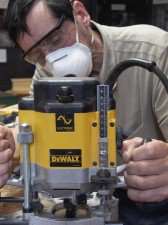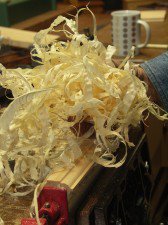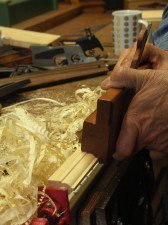Power versus power
Power versus power began for me thirty plus years ago when I began questioning workshop safety. I complied with all regulations yet at the end of the day using power equipment I was coughing up junk like a veteran smoker. Only trouble was I didn’t smoke!

We often look at power woodworking as having provided power to our work and eased us from the drudgery, which sometimes it might. But there is a price to pay and we have to face it. Machines are driven by electric power. They actually deliver far more power than we can use effectively and far more power than we actually need too. If you are not particularly strong. I mean muscularly strong, like manly strong, these power machines are in fact highly dangerous. I think that many power tools are too dangerous for most women to use and also many men too and most women, when introduced to power machines like the one shown, feel reticent to try them. Fact is, they are right to feel intimidated. Fact is, their wrists are most often too small and their hands are not big enough either. Their hand, wrist and upper body weight-to-strength ratio is different than a man’s too. This can be true of other machines also. Table saws, chop saws and so on. So, it’s all a matter of perspective. To a large percentage of women, to all children under 16 at the earliest, to a percentage of men, power tools are not empowering tools but really very dangerous.
On the other hand, a well-sharpened chisel, saw, plane, ax, spokeshave, delivers the exact power the people I just listed need to get the job done efficiently and safely. They are indeed power tools with dynamism. You provide the power, direction according to your will and energy levels. Quite simple really. Further still, what about skill? You are developing a working knowledge of the wood and you are developing real skill.
Now look at this. One moulding plane cuts a foot long mould in 15 seconds. So 10′ long stick takes 2 1/2 minutes. The plane is 150 years old. Now that’s power!
Pick up a chisel and mallet tomorrow. Who needs moulds (molds UK) on every square edge anyway. All they do is make your work look like the stuff from Ikea anyway. Forget the rugged-individual look. That’s all imagery anyway and nothing more. Look beyond the face shields and the dust masks and see the face behind the disguise. They’re not woodworkers at all usually.

Now, you’ve been working for an hour with your router and turned on the tablesaw a few times too. These two “power tools” charge the air with masses of dust no matter how good your extraction system. What’s the very first thing you do when the machining is done? I mean immediately? That’s right, you can’t wait to get that dust mask off not matter how good it is, or lightweight it is. After all, the machine is stopped and you have had the dust extractor on the whole time and also the shop air filter too; just for good measure. Fact is that the air is still charged with finings that you cannot see and this that you cannot see is the most dangerous of all the dusts. It will commonly stay in the area you are working in for an hour or more. You breath it into your lungs, throat and nasal passages after the mask has been removed. Welcome to freedom as you race the open range with your 20 pack with your friends riding beside you! Think about. More power to you!



Blimey a picture of Paul holding a router! I did resort to using one when after completing the shelves I made on the course with you carefully and lovingly using hand tools my wife said 'but where is the back' so after assembly the easiest way (I felt anyway) was to route a rebate incl the depth of the shelf. Looks good though.
Yes, I had to wrestle with this one, but I want to show a balanced perspective and address the imbalances crated by power machine makers.
It makes perfect sense to use the router for what you did. I have no question about that. However, you must admit a little itty bitty concern about what would happen if something went wrong, right? I mean I have known routers pick up projects like that and twist on the heel when you least expect it. And I have used routers for extended periods; as long as most any other woodworker.
I can honestly say though that if I had known how to do it without the router I would have done. I am not in a rush and don't have to cost my time being a hobby woodworker. Apart from that one occassion lighting and radio aside no electricity has been used in the workshop since I saw you!
Wow! I am impressed. What works quite well is to run a marking gauge around the inside lip of the area to be rebated to make a definitive score line. Then run another gauge line for the depth line. You can work most of the waste wood out with a 1" chisel quite easily using a mallet. When down, near to the gauge line, revert to a well sharpened bullnose. This will level out unevenness and will match anything you can achieve with the machine router.